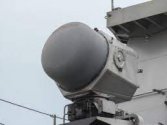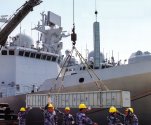Surprising interview, according to the interview of Song Jigang, captain of the missile area of the Bingzhou ship, in last year's exercise, the command set the 054A radar damage to be unusable, and completely relied on the data transmitted by the AWACS ,HQ-16 hit the target. Considering that the AWACS cannot provide fire-control-level radar data, this seems to imply that the HQ-16 does have an active seeker to capture targets on its own.
Not really. People cannot assume that every SARH guided missile uses dumb illuminators like SPG-62 that requires an external radar to direct the illuminators. Illuminator like SPG-62 are one way --- they send out a beam, and they themselves do not process the reflection of that beam. These devices are not true radars, as a Radar by its acronym means RAdio Detection And Ranging. They need another radar which is in this case, the SPY-1, to detect, track and range the target, and to queue the illuminator. The reflections is for the radio guided seeker of the missile to home in.
The target illuminators for Buk/HQ-16 are not dumb. They can track targets and illuminate them at the same time. This means that the illuminator shines the target, the reflections also goes back to the illuminator, which then tracks and ranges the target at the same time, while the reflections also goes to the radio seeker of the missile to home in. So these illuminators, unlike the SPG-62, are true radars.
The main search radar of the Type 054A, the Type 382, which is based and works on the same principle as the Fregat used by the Soviet Navy, by itself does not provide enough resolution and rate of update necessary for fire control. It finds the targets and sends the data to the combat computer which assigns each of the four illuminators to independently track, engage and illuminate the targets. These illuminators generate their own fire control data to track and range their targets and to keep it lit without additional help of the search radar beyond initializing the engagement.

Even if the main search radar is knocked down, the illuminators will continue to prosecute the already engaged targets to their conclusion. After that, they will have to depend on another radar source to find and initialize engagement on the next wave of targets, which on this case, is an AEW. But it can also be another ship through a datalink, or the ship's other secondary radars, such as the Type 364 and Type 366.
Fire control radars and illuminators work with pencil thin beams that are not suited for scanning wide swathes of the sky to search and detect objects. Search radars produce wide fan like beam patterns that will scan the sky in such wide swathes as they are turned around a full 360 degrees. Once the search radar detects the object, interrogates it with IFF, determines its hostility, it can queue the FCR or target illuminator towards the target, which then shines its thin beams to it. From then on, the search radar continues to search for more targets while the FCR tracks and sticks its beam to the target like a glue until the target is destroyed. This also works with FCRs that manage gunnery, which in this case for the Type 054A, the Type 347G radar is also used to engage aerial targets with the 76mm gun. After the target is destroyed, the search radar assigns a new set of targets to the FCRs and illuminators.


